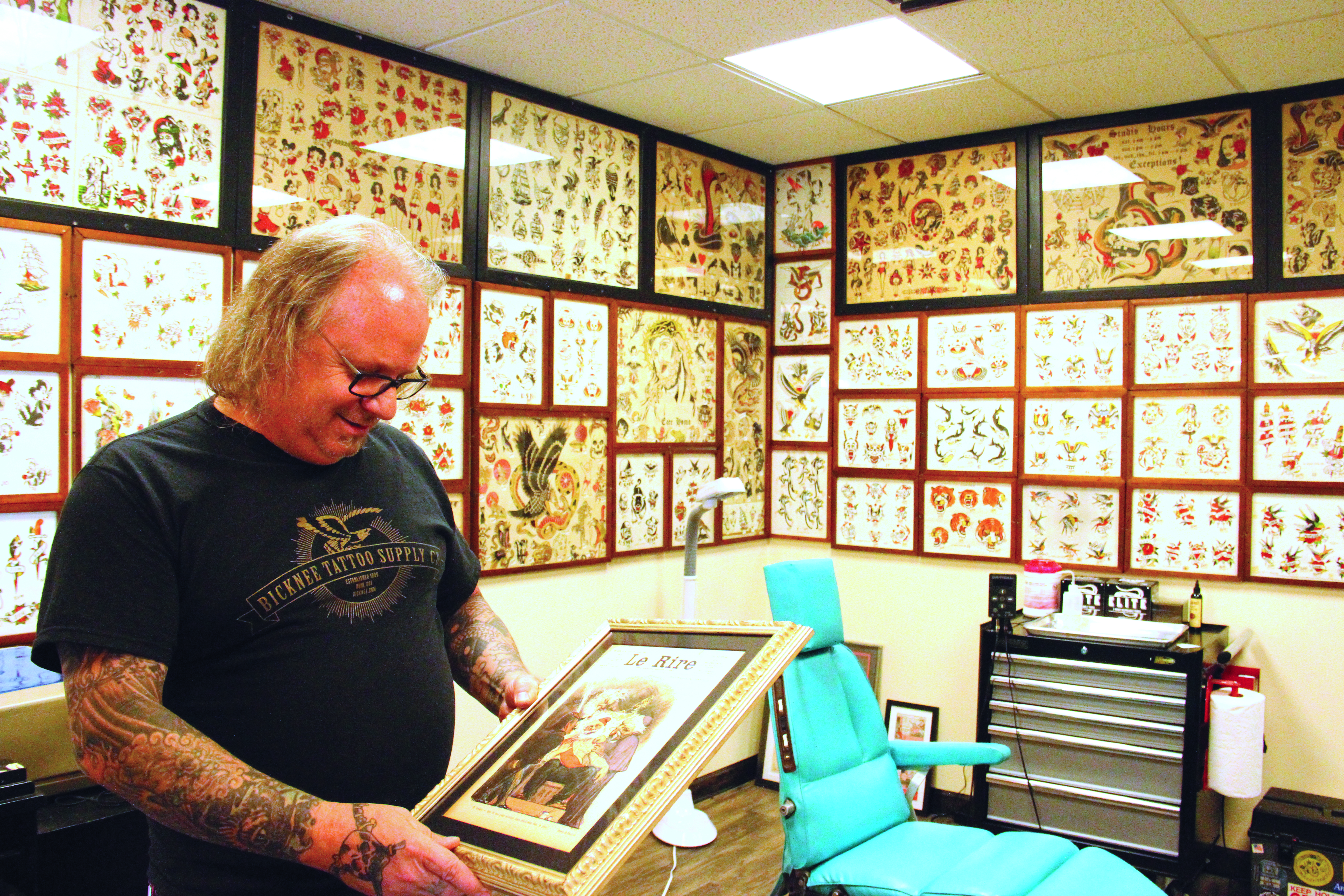
After a profitable Kickstarter campaign, owner Rich Thomas introduces the latest incarnation of his lifelong tattoo museum project to the Bidwell community.
Just west of Gallipolis, a small, golden building sticks out among the neutral scenery. Were it not for its striking yellow exterior, the boxy structure might go unnoticed along Jackson Pike in Bidwell. However, its eye-catching color hints at its distinct content: all things tattoo.
The Man Behind the Museum
The Ohio Tattoo Museum is a showcase for tattoo history. Its adjoining Bicknee Tattoo Supply Company sells materials to licensed tattoo artists. Owner Rich Thomas took over the location two years ago, but he has 20 years of experience in the tattoo industry.
Thomas says his interest in body art started in high school after receiving his first tattoo, a free hand style piece performed by a friend. He soon evolved from hand poked pieces. By the 90s, Thomas was a seasoned tattoo artist himself. He cites this time as the beginning of his museum aspirations.
Cooke’s Collection
In 1999, Thomas acquired a vast collection of tattoo design sheets, also called “flash sheets.” The sheets once belonged to legendary collector Al Cooke, a Cleveland business man. According to Thomas, Cooke himself was never tattooed. However, he was on friendly terms with many prominent tattoo artists, during the Roaring 20s and on to the 1950s. Thomas says attaining even a portion of Cooke’s collection was akin to finding the holy grail of tattoo history.
“I thought, ‘I’ve got to display this stuff.’ I just kind of had a room in the back of the shop and I’d already been collecting stuff since the mid-80s,” Thomas says. “I was crazy about tattoo sheets. I had a big collection of machines already, antique and otherwise.”
As Thomas’ collection grew and expanded beyond the Cooke collection, so did its prominence in his life. Eventually, he closed his tattoo parlor and refocused solely on the museum and supply business.
Yesterday’s Dream, Today’s Reality
Today, the museum’s plush, red velvet ropes encircle the perimeter of the room. The rope’s hue highlights the classic color scheme of the design sheets that sit in their glass cases. Black and white photographs are dispersed throughout the room. They detail iconic individuals in the tattoo industry. Standing cases placed throughout the center of the room also showcase antique tattooing machines and other artifacts.
Thomas’ friend and museum supporter Kevin Riley sees the museum as an asset to the tattoo community. “It’s really important that the people who have awesome collections of artwork don’t just keep it a secret and not allow the public to get a chance to appreciate it,” Riley says.
Since its opening, visitors from Australia, Europe and South America, among others, have travelled to the museum, according to Thomas. With the recent reopening of the museum, Thomas expects the attendance to continue in a similar fashion.
George Keeler, an employee and longtime friend of Thomas’, also feels that the new location will entice guests. “The response has been good. It’s a destination point for tattooers …It’s impressive the amount of people that have made the journey to come,” Keeler says.
Kickstarting the Community
Those supporters are key figures in the museum’s most recent chapter. In February 2015, Thomas started a Kickstarter campaign that raised $15,739 for the museum in just 45 days.
“It’s been a heartwarming experience. People I had no idea would help came out from the tattoo world,” Thomas says. Because of the campaign, the museum is entirely patron-backed. Their names grace the plaques hanging next to the museum’s entrance.
While the funds allowed Thomas cushion to expand his operation, the project was never about extra flow. “It’s like a labor of love, not really a money maker,” Thomas says. But despite the success of the reopening, one of the most surprising elements of the experience goes beyond the museum itself, but the very nature of its contents.
“I’ve been collecting long enough that stuff I didn’t think was an antique is now becoming an antique,” Thomas says with a chuckle. And given the ever-evolving nature of the museum’s contents, his work has infinite potential.
